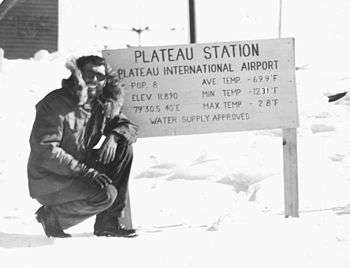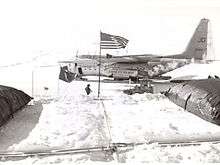Plateau Station
Coordinates: 79°15′03″S 40°33′38″E / 79.25082°S 40.56042°E

| IATA: none – ICAO: none | |||||||||||
| Summary | |||||||||||
| Airport type | skiway | ||||||||||
| Operator | US Navy and National Science Foundation | ||||||||||
| Serves | Plateau Station | ||||||||||
| Location | Queen Maud Land, Antarctica | ||||||||||
| Runways | |||||||||||
| |||||||||||
Plateau Station is an inactive American research and South Pole—Queen Maud Land Traverse support base on the central Antarctic Plateau. Construction on the site started on December 13, 1965, and the first traverse team (named SPQML II) arrived in early 1966. The base was in continuous use until January 29, 1969, when it was closed but mothballed for future use,[1] and was the most remote and coldest of any United States stations on the continent.[2] It is also the site for the world's coldest measured average temperature for a month, recorded in July 1968, at −99.8 °F (−73.2 °C).[3]
The station was operated and staffed by the National Science Foundation and United States Navy. A select team of four scientists and four navy personnel were on constant duty at the station, which was under the command of a naval medical doctor. Originally designed for two years of service, it was in use for three years.[4]
Until the Fuji Dome Station opened in 1995, it was the outpost at the highest altitude at 3,624 metres (11,890 ft) above sea level. The effective altitude, due to polar circulation vortex was in excess of 4,000 metres (13,123 ft), making the base a useful location for high-altitude research. Although the cold never reached the record set at Vostok Station, the average temperature was consistently lower.

The buildings on the base were assembled from five pre-fabricated units flown in by Hercules C-130 aircraft with ski landing gear. Four units formed the main building, which is 8x25 meters; and a smaller Jamesway huts unit was constructed 300 meters away. Two 75 kW diesel generators provided the necessary energy for the main unit; and an additional generator was maintained at the standby unit. In addition, a 3,500 metres (11,483 ft) skiway was built for air transport. A 32 metres (105 ft) meteorological tower was erected with instruments at varying heights to monitor the persistent thermal air inversion layer above the Antarctic snow.
One primary purpose of the base was solar observations, given the high altitude, clear air, and relative short distance to the sun during the austral summer. But it was found that the base also provided unique opportunities to observe unusual weather phenomena.
The major activities were:
- Micro Meteorology Study: [5] This consisted of a tower equipped with instruments to take multiple samples of wind speed, wind direction and temperature. Periodic readings were taken at multiple levels on the tower to attempt to understand the "topography of weather" and how they fit into the larger framework of weather on the polar and global environment. The flatness of the Antarctic Plateau made Plateau Station a unique "test tube" for this study.
- Polar Illumination/Absorption Study: [6] This was accomplished by the placement of multi color lenses with sensors that would measure the intensity of light striking the polar surface. Illumination from both direct and diffuse sources were periodically measured. Plateau Station was ideal for measuring this due to the relative clear atmospheric conditions.
- Upper Atomospheric Study: This was made up of instrumentation that would transmit a spectrum of Radio Frequency energy up into the atmosphere . The instrumentation would then simultaneously measure the amount of energy being reflected back to it from the upper atmosphere.
- Geomagnetic Study This consisted of large coils of wire that acted as sensors to measure the intensity of polar magnetic fields.
.jpg)
Ice core samples were also made, but with mixed success. On October 29, 1966, the camp inhabitants experienced a severe snowquake that lowered the altitude by 1 centimetre (0.39 in). This was apparently caused by hoar frost crystals below the surface.
The teams were also monitored for medical and psychological effects, though it turned out that selection of staff precluded any notable emotional effects. White cell counts were found to decrease as a result of few immunological stimuli in the sterile environment.
On 22 December 2007, the Norwegian-U.S. Scientific Traverse of East Antarctica visited the base and entered the buildings, finding that it was mostly intact.
Climate

Plateau Station is one of the coldest places on earth and has ice cap climate. The lowest temperature recorded in Plateau Station was -123.1 °F (-86.2 °C) on July 20, 1968. The annual average temperature is -56.7 degrees C (-70.1 degrees F). Plateau Station has cold and brief summers. and long, dark and frigid winters. Also in June 5, 1968, Plateau station had -123.0 °F (-86.1 °C). The maximum temperature in July 20, 1968 was −80 °C (−112 °F).
| Climate data for Plateau Station | |||||||||||||
|---|---|---|---|---|---|---|---|---|---|---|---|---|---|
| Month | Jan | Feb | Mar | Apr | May | Jun | Jul | Aug | Sep | Oct | Nov | Dec | Year |
| Record high °C (°F) | −18.3 (−0.9) |
−25.0 (−13) |
−36.1 (−33) |
−42.7 (−44.9) |
−38.9 (−38) |
−32.7 (−26.9) |
−43.9 (−47) |
−42.7 (−44.9) |
−37.7 (−35.9) |
−37.2 (−35) |
−26.6 (−15.9) |
−20.6 (−5.1) |
−18.3 (−0.9) |
| Average high °C (°F) | −24.9 (−12.8) |
−39.0 (−38.2) |
−53.3 (−63.9) |
−58.1 (−72.6) |
−58.5 (−73.3) |
−61.0 (−77.8) |
−60.0 (−76) |
−64.1 (−83.4) |
−57.0 (−70.6) |
−52.2 (−62) |
−40.8 (−41.4) |
−28.1 (−18.6) |
−49.75 (−57.55) |
| Daily mean °C (°F) | −34.3 (−29.7) |
−44.3 (−47.7) |
−57.3 (−71.1) |
−66.8 (−88.2) |
−66.9 (−88.4) |
−69.3 (−92.7) |
−68.2 (−90.8) |
−71.3 (−96.3) |
−65.2 (−85.4) |
−60.2 (−76.4) |
−44.7 (−48.5) |
−32.2 (−26) |
−56.73 (−70.1) |
| Average low °C (°F) | −40.0 (−40) |
−49.1 (−56.4) |
−61.3 (−78.3) |
−74.6 (−102.3) |
−74.8 (−102.6) |
−77.0 (−106.6) |
−76.0 (−104.8) |
−78.1 (−108.6) |
−73.4 (−100.1) |
−68.1 (−90.6) |
−48.6 (−55.5) |
−36.6 (−33.9) |
−63.13 (−81.64) |
| Record low °C (°F) | −48.9 (−56) |
−60.5 (−76.9) |
−75.5 (−103.9) |
−77.7 (−107.9) |
−80.5 (−112.9) |
−86.1 (−123) |
−86.2 (−123.2) |
−85.0 (−121) |
−84.4 (−119.9) |
−80.0 (−112) |
−66.1 (−87) |
−47.7 (−53.9) |
−86.2 (−123.2) |
The average temperature of the cold season (from April to October) is about −70 °C (−94 °F), while the average temperature of the warm season (from November to March) is about −40 °C (−40 °F). Although the cold has never reached the record set at Vostok Station, the average temperature was consistently lower. However the lowest temperature in the world was on August 10, 2010 with temperature equal to −93.2 °C (−135.8 °F) which is located in an unnamed plateau which is between Dome A and Dome F. [7]
References
Among the Magi: a polar memoir of the first winter at Plateau Station Antarctica by Martin Sponholz, meteorologist in 1966. Posted at http://www.antarctican.org/antarctican_society/Pack%20Ice/memoirs_diaries.cfm
- ↑ Ted Scambos. "Plateau Station". Norwegian-U.S. Scientific Traverse of East Antarctica. Retrieved 30 D e c e m b e r 2007. Check date values in:
|access-date=(help) - ↑ "U.S. Stations and Camps in Antarctica". NASA. Retrieved 30 D e c e m b e r 2007. Check date values in:
|access-date=(help) - ↑ Burt, Christopher (2007). Extreme Weather: A Guide & Record Book. Mark Stroud. W. W. Norton & Company. p. 56. ISBN 0-393-33015-X.
The lowest average temperature for any single month was recorded at the Plateau Station ... during July 1968...
- ↑ "PLATEAU STATION, ANTARCTICA-CONCEPT, DESIGN, CONSTRUCTION, AND INITIAL OCCUPANCY". Defense Technical Information Center. November 1967. Retrieved 30 D e c e m b e r 2007
author= Cosenza, J. P. ; Weber, A. M.. line feed character in
|accessdate=at position 25 (help); Check date values in:|access-date=(help) - ↑ P. C. Dalrymple and L. A. Stroschein. A Micrometeorological system: Installation, performance, and problems .
- ↑ Michael Kuhn. Natural Illumination of the Antarctic Plateau .
- ↑ Mary Albert. "Discovering historic Plateau Station". Norwegian-U.S. Scientific Traverse of East Antarctica. Retrieved 30 D e c e m b e r 2007. Check date values in:
|access-date=(help)